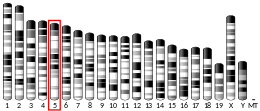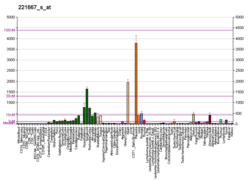HSPB8
Heat shock protein beta-8 is a protein that in humans is encoded by the HSPB8 gene.[5][6][7]
Clinical importance
Mutations in this gene have been associated with an autosomal dominant rimmed vacuolar myopathy[11] The clinical features of this condition are distal and proximal myopathy. MRI show severe relatively symmetric multifocal fatty degenerative changes within the muscles. Muscle biopsy shows rimmed vacuoles, muscle fiber atrophy and endomysial fibrosis.
References
- GRCh38: Ensembl release 89: ENSG00000152137 - Ensembl, May 2017
- GRCm38: Ensembl release 89: ENSMUSG00000041548 - Ensembl, May 2017
- "Human PubMed Reference:". National Center for Biotechnology Information, U.S. National Library of Medicine.
- "Mouse PubMed Reference:". National Center for Biotechnology Information, U.S. National Library of Medicine.
- Smith CC, Yu YX, Kulka M, Aurelian L (Sep 2000). "A novel human gene similar to the protein kinase (PK) coding domain of the large subunit of herpes simplex virus type 2 ribonucleotide reductase (ICP10) codes for a serine-threonine PK and is expressed in melanoma cells". J Biol Chem. 275 (33): 25690–9. doi:10.1074/jbc.M002140200. PMID 10833516.
- Charpentier AH, Bednarek AK, Daniel RL, Hawkins KA, Laflin KJ, Gaddis S, MacLeod MC, Aldaz CM (Nov 2000). "Effects of estrogen on global gene expression: identification of novel targets of estrogen action". Cancer Res. 60 (21): 5977–83. PMID 11085516.
- "Entrez Gene: HSPB8 Heat shock 22kDa protein 8".
- Sun X, Fontaine JM, Rest JS, Shelden EA, Welsh MJ, Benndorf R (Jan 2004). "Interaction of human HSP22 (HSPB8) with other small heat shock proteins". J. Biol. Chem. 279 (4): 2394–402. doi:10.1074/jbc.M311324200. PMID 14594798.
- Benndorf R, Sun X, Gilmont RR, Biederman KJ, Molloy MP, Goodmurphy CW, Cheng H, Andrews PC, Welsh MJ (Jul 2001). "HSP22, a new member of the small heat shock protein superfamily, interacts with mimic of phosphorylated HSP27 ((3D)HSP27)". J. Biol. Chem. 276 (29): 26753–61. doi:10.1074/jbc.M103001200. PMID 11342557.
- Irobi J, Van Impe K, Seeman P, Jordanova A, Dierick I, Verpoorten N, Michalik A, De Vriendt E, Jacobs A, Van Gerwen V, Vennekens K, Mazanec R, Tournev I, Hilton-Jones D, Talbot K, Kremensky I, Van Den Bosch L, Robberecht W, Van Vandekerckhove J, Van Broeckhoven C, Gettemans J, De Jonghe P, Timmerman V (Jun 2004). "Hot-spot residue in small heat-shock protein 22 causes distal motor neuropathy". Nat. Genet. 36 (6): 597–601. doi:10.1038/ng1328. PMID 15122253.
- Al-Tahan S, Weiss L, Yu H, Tang S, Saporta M, Vihola A, Mozaffar T, Udd B, Kimonis V (2019) New family with HSPB8-associated autosomal dominant rimmed vacuolar myopathy. Neurol Genet 5(4):e349
Further reading
- Hu Z, Chen L, Zhang J, Li T, Tang J, Xu N, Wang X (2007). "Structure, function, property, and role in neurologic diseases and other diseases of the sHsp22". J. Neurosci. Res. 85 (10): 2071–9. doi:10.1002/jnr.21231. PMID 17304582.
- Timmerman V, Raeymaekers P, Nelis E, De Jonghe P, Muylle L, Ceuterick C, Martin JJ, Van Broeckhoven C (1992). "Linkage analysis of distal hereditary motor neuropathy type II (distal HMN II) in a single pedigree". J. Neurol. Sci. 109 (1): 41–8. doi:10.1016/0022-510X(92)90091-X. PMID 1517763.
- Berciano J, Combarros O, Figols J, Calleja J, Cabello A, Silos I, Coria F (1986). "Hereditary motor and sensory neuropathy type II. Clinicopathological study of a family". Brain. 109 ( Pt 5) (5): 897–914. doi:10.1093/brain/109.5.897. PMID 3022865.
- Jansen PH, Joosten EM, Jaspar HH, Vingerhoets HM (1986). "A rapidly progressive autosomal dominant scapulohumeral form of spinal muscular atrophy". Ann. Neurol. 20 (4): 538–40. doi:10.1002/ana.410200417. PMID 3789668.
- Meadows JC, Marsden CD (1969). "A distal form of chronic spinal muscular atrophy". Neurology. 19 (1): 53–8. doi:10.1212/wnl.19.1.53. PMID 5813127.
- D'Alessandro R, Montagna P, Govoni E, Pazzaglia P (1982). "Benign familial spinal muscular atrophy with hypertrophy of the calves". Arch. Neurol. 39 (10): 657–60. doi:10.1001/archneur.1982.00510220055013. PMID 7125978.
- Groen RJ, Sie OG, van Weerden TW (1993). "Dominant inherited distal spinal muscular atrophy with atrophic and hypertrophic calves". J. Neurol. Sci. 114 (1): 81–4. doi:10.1016/0022-510X(93)90053-2. PMID 8433103.
- Timmerman V, De Jonghe P, Simokovic S, Löfgren A, Beuten J, Nelis E, Ceuterick C, Martin JJ, Van Broeckhoven C (1997). "Distal hereditary motor neuropathy type II (distal HMN II): mapping of a locus to chromosome 12q24". Hum. Mol. Genet. 5 (7): 1065–9. doi:10.1093/hmg/5.7.1065. PMID 8817349.
- Irobi J, Tissir F, De Jonghe P, De Vriendt E, Van Broeckhoven C, Timmerman V, Beuten J (2000). "A clone contig of 12q24.3 encompassing the distal hereditary motor neuropathy type II gene". Genomics. 65 (1): 34–43. doi:10.1006/geno.2000.6149. PMID 10777663.
- Aurelian L, Smith CC, Winchurch R, Kulka M, Gyotoku T, Zaccaro L, Chrest FJ, Burnett JW (2001). "A novel gene expressed in human keratinocytes with long-term in vitro growth potential is required for cell growth". J. Invest. Dermatol. 116 (2): 286–95. doi:10.1046/j.1523-1747.2001.00191.x. PMID 11180006.
- Wiemann S, Weil B, Wellenreuther R, Gassenhuber J, Glassl S, Ansorge W, Böcher M, Blöcker H, Bauersachs S, Blum H, Lauber J, Düsterhöft A, Beyer A, Köhrer K, Strack N, Mewes HW, Ottenwälder B, Obermaier B, Tampe J, Heubner D, Wambutt R, Korn B, Klein M, Poustka A (2001). "Toward a Catalog of Human Genes and Proteins: Sequencing and Analysis of 500 Novel Complete Protein Coding Human cDNAs". Genome Res. 11 (3): 422–35. doi:10.1101/gr.GR1547R. PMC 311072. PMID 11230166.
- Simpson JC, Wellenreuther R, Poustka A, Pepperkok R, Wiemann S (2001). "Systematic subcellular localization of novel proteins identified by large-scale cDNA sequencing". EMBO Rep. 1 (3): 287–92. doi:10.1093/embo-reports/kvd058. PMC 1083732. PMID 11256614.
- Yu YX, Heller A, Liehr T, Smith CC, Aurelian L (2001). "Expression analysis and chromosome location of a novel gene (H11) associated with the growth of human melanoma cells". Int. J. Oncol. 18 (5): 905–11. doi:10.3892/ijo.18.5.905. PMID 11295034.
- Benndorf R, Sun X, Gilmont RR, Biederman KJ, Molloy MP, Goodmurphy CW, Cheng H, Andrews PC, Welsh MJ (2001). "HSP22, a new member of the small heat shock protein superfamily, interacts with mimic of phosphorylated HSP27 ((3D)HSP27)". J. Biol. Chem. 276 (29): 26753–61. doi:10.1074/jbc.M103001200. PMID 11342557.
- Kappé G, Verschuure P, Philipsen RL, Staalduinen AA, Van de Boogaart P, Boelens WC, De Jong WW (2001). "Characterization of two novel human small heat shock proteins: protein kinase-related HspB8 and testis-specific HspB9". Biochim. Biophys. Acta. 1520 (1): 1–6. doi:10.1016/s0167-4781(01)00237-8. PMID 11470154.
- Suzuki H, Fukunishi Y, Kagawa I, Saito R, Oda H, Endo T, Kondo S, Bono H, Okazaki Y, Hayashizaki Y (2001). "Protein–Protein Interaction Panel Using Mouse Full-Length cDNAs". Genome Res. 11 (10): 1758–65. doi:10.1101/gr.180101. PMC 311163. PMID 11591653.
- Molloy MP, Andrews PC (2002). "Phosphopeptide derivatization signatures to identify serine and threonine phosphorylated peptides by mass spectrometry". Anal. Chem. 73 (22): 5387–94. doi:10.1021/ac0104227. PMID 11816564.
- Depre C, Hase M, Gaussin V, Zajac A, Wang L, Hittinger L, Ghaleh B, Yu X, Kudej RK, Wagner T, Sadoshima J, Vatner SF (2002). "H11 kinase is a novel mediator of myocardial hypertrophy in vivo". Circ. Res. 91 (11): 1007–14. doi:10.1161/01.RES.0000044380.54893.4B. PMID 12456486.
This article is issued from Wikipedia. The text is licensed under Creative Commons - Attribution - Sharealike. Additional terms may apply for the media files.




